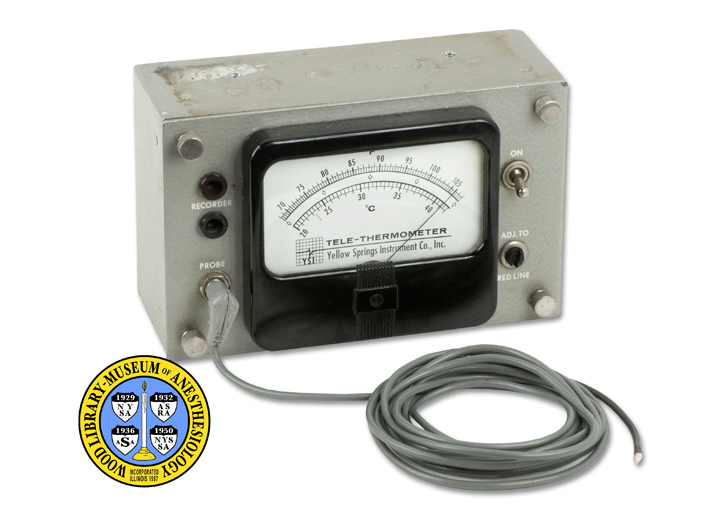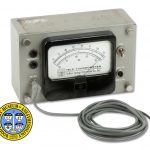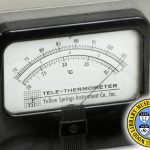Tele-Thermometer
The Tele-Thermometer, introduced in 1954, was made by Yellow Springs Instrument Co., of Yellow Springs, Ohio. It is an example of the early devices that first enabled anesthesiologists to regularly or continuously obtain accurate body temperatures of anesthetized patients. These new monitoring tools marked a significant improvement in patient safety.
While some surgeries require the anesthesiologist to induce a low body temperature and control it within a narrow temperature range, most of the time anesthesiologists want to prevent their patient’s body temperature from falling too low. Several factors may cause a patient’s temperature to fall during surgery, including the anesthetics themselves. Excessively low body temperatures increase the risk of complications during and after surgery. The advent of these thermometers also enabled anesthesiologists to respond more quickly to a rare but dangerous complication called malignant hyperthermia. A primary symptom of this condition is a rapidly rising body temperature.
Catalog Record: Tele-Thermometer
Access Key: aikw
Accession No.: 1995-08-25-1 AA
Title: Tele-thermometer [with rectal probe].
Corporate Author: YSI Inc.
Title variation: Alt Title
Title: Yellow Springs rectal thermometer.
Title variation: Alt Title
Title: Thermistor-thermometer.
Publisher: Yellow Springs, Ohio : Yellow Springs Instrument Co., [1955-1979?].
Physical Description: 1 electronic thermometer and 1 probe : enameled steel, plastic, vinyl, copper, constantan, nickel ; 9 x 19 x 12 cm.
Subject: Monitoring, Intraoperative.
Subject: Monitors.
Subject: Thermometers.
Subject: Temperature Probes.
Subject: Temperature Measurement.
Note Type: General
Notes: Title from face of instrument, with descriptive addition based on the WLM
name for the artifact.
Note Type: Citation
Notes: Ball C. Temperature monitoring. Anaesth Intensive Care. 2010;38(3):413.
Note Type: Citation
Notes: Dornette, WHL. The use of temperature monitoring devices in anesthesia. Curr
Res Anesth Analg. 1956;35(6):584-599.
Note Type: Physical Description
Notes: Portable, battery powered thermistor thermometer, with enameled steel shell;
On the front, or face, is a needle meter with curved, finely marked scales;
Upper scale is marked in Fahrenheit from 68-108 degrees with ‘minor’ marks
indicating every half-degree; Numbers and ‘major’ marks indicate every 5
degrees from 70 to 105 degrees Fahrenheit; Lower scale is marked in Celsius
from 20-42 degrees; ‘Minor’ marks indicate every half degree Celsius; ‘Major’
marks indicate every 5 degrees Celsius; Manufacturer’s markings below the
scales: [to the right of the manufacturers logo is] “TELE-THERMOMETER” [new
line] “Yellow Springs Instrument Co., Inc.”; A line extends from the logo
horizontally to a space between the name of the instrument and the
manufacturer; The face of the meter is protected by a transparent plastic
cover surrounded by a more rigid, black plastic frame; On the right side of
the face, to the right of the meter, is the on-off toggle switch; Below the
switch is a red-colored jack, or port, for one of the leads to the recorder,
marked :”ADJ TO” [above jack] “RED LINE” [below jack]; Left of the face,
marked between a red and black jack is “RECORDER” (the red jack is situated
above the black jack; Below the black recorder jack is the jack for the
thermistor probe; A metal tag is affixed to the back of the thermometer; The
model and serial numbers are marked on the tag, along with the manufacturers’
logo, name, city and state: [All text is centered and to the right of the
logo] “Yellow Springs” [new line] Instrument Co., Inc. [new line] Yellow
Springs, Ohio [new line] Model 43TA Serial 9949; Etched on the top “Gray –
Anesthesia”; With the thermometer is a reusable, flexible, vinyl covered,
copper and constantan (a copper-nickel alloy) wire probe of 3 meters in
length; The probe has a nickel electroplated, copper and constantan plug.
Note Type: Reproduction
Notes: Photographed by Mr. William Lyle July 13, 2010.
Note Type: Acquisition
Notes: Donated to the WLM by Dr. Elliott V. Miller.
Note Type: Historical
Notes: The Tele-Thermometer is an example of the early devices that first enabled
anesthesiologists to regularly or continuously obtain accurate body
temperatures of anesthetized patients. Postoperative “heat stroke” (later
identified as malignant hyperthermia) was recognized as a potential surgical
complication as early as 1900, and by 1959 hypothermia was commonly induced
for a variety of surgeries (Ball, 2010). In a 1956 article from Anesthesia &
Analgesia, Dr. William Dornette discussed the need for anesthesiologists to
monitor temperature, reviewed a number of “thermal sensing devices”, and
described ideal design features for such devices. The ability to regularly or
continuously, and accurately, obtain core body temperatures of patients
during surgery marks a significant improvement in patient safety.



